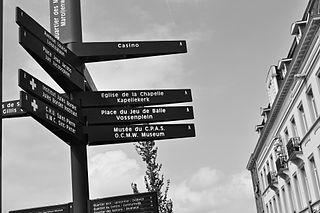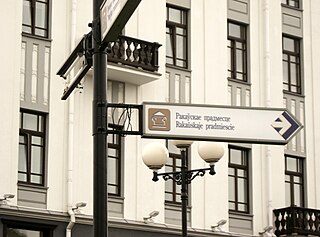
The United Nations Economic and Social Council is one of the six principal organs of the United Nations, responsible for coordinating the economic and social fields of the organization, specifically in regards to the fifteen specialised agencies, the eight functional commissions, and the five regional commissions under its jurisdiction.
The United Nations Commission on Human Rights (UNCHR) was a functional commission within the overall framework of the United Nations from 1946 until it was replaced by the United Nations Human Rights Council in 2006. It was a subsidiary body of the UN Economic and Social Council (ECOSOC), and was also assisted in its work by the Office of the United Nations High Commissioner for Human Rights (UNOHCHR). It was the UN's principal mechanism and international forum concerned with the promotion and protection of human rights.
Toponymy, toponymics, or toponomastics is the study of toponyms, including their origins, meanings, usage and types. Toponym is the general term for a proper name of any geographical feature, and full scope of the term also includes proper names of all cosmographical features.
The consultative status is a phrase that has been in use since the establishment of the United Nations and is used within the UN community to refer to "Non-governmental organizations (NGOs) in Consultative Status with the United Nations Economic and Social Council". Also some international organizations could grant Consultative Status to NGOs. Organization for Security and Co-operation in Europe (OSCE) could grant Consultative Status in the form of "Researcher-in-residence programme" : accredited representatives of national and international NGOs are granted access to all records and to numerous topical compilations related to OSCE field activities.
ISO 15919 is one of a series of international standards for romanization by the International Organization for Standardization. It was published in 2001 and uses diacritics to map the much larger set of consonants and vowels in Brahmic and Nastaliq scripts to the Latin script.

The United Nations Statistical Commission (StatCom) is a Functional Commission of the United Nations Economic and Social Council, established in 1947. The Statistical Commission oversees the work of the United Nations Statistics Division (UNSD). Its 24 member states are elected by the Economic and Social Council on the basis of the following geographical distribution: African states (5), Asian States (4), Eastern European States (4), Latin American and Caribbean States (4), Western European and other States (7). Since July 1999 the Commission meets every year. As set forth by the Economic and Social Council, in the terms of reference, the Commission shall assist the Council:

The Ukrainian Latin alphabet is the form of the Latin script used for writing, transliteration and retransliteration of Ukrainian.
The World Network of Users and Survivors of Psychiatry (WNUSP) is an international organisation representing, and led by what it terms "survivors of psychiatry". As of 2003, over 70 national organizations were members of WNUSP, based in 30 countries. The network seeks to protect and develop the human rights, disability rights, dignity and self-determination of those labeled 'mentally ill'.
Romanization or Latinization of Belarusian is any system for transliterating written Belarusian from Cyrillic to the Latin alphabet.
GOST 16876-71 is a romanization system devised by the National Administration for Geodesy and Cartography of the Soviet Union. It is based on the scientific transliteration system used in linguistics. GOST was an international standard so it included provision for a number of the languages of the Soviet Union. The standard was revised twice in 1973 and 1980 with minor changes.

Language politics is the way language and linguistic differences between peoples are dealt with in the political arena. This could manifest as government recognition, as well as how language is treated in official capacities.

Instruction on transliteration of Belarusian geographical names with letters of Latin script is an official standard of Romanization of Belarusian geographical names.
The Intergovernmental Working Group of Experts on International Standards of Accounting and Reporting (ISAR) is hosted by the United Nations Conference on Trade and Development (UNCTAD). Created in 1982 by the United Nations Economic and Social Council (ECOSOC), its mission is to facilitate investment, development and economic stability by promoting good practices in corporate transparency and accounting.

A district or raion in Belarus is the second-level administrative division in the country which are subordinate to regions.
The United Nations Guidelines for Consumer Protection (UNGCP) relate to consumer protection goals. The statement supplied is that the guidelines are "a valuable set of principles for setting out the main characteristics of effective consumer protection legislation, enforcement institutions and redress systems and for assisting interested Member States in formulating and enforcing domestic and regional laws, rules and regulations that are suitable to their own economic and social and environmental circumstances, as well as promoting international enforcement cooperation among Member States and encouraging the sharing of experiences in consumer protection."
Josef Breu was an Austrian geographer and cartographer and for several years Chair of the United Nations Group of Experts on Geographical Names (UNGEGN).
The United Nations Committee of Experts on Global Geospatial Information Management (UN-GGIM) is one of the nine expert groups of the United Nations Economic and Social Council (ECOSOC) and to foster the global development geospatial information.

The United Nations Committee of Experts on Public Administration (CEPA) is an expert body that meets under the auspices of the United Nations Economic and Social Council in order to discuss and find ways to support the work of the Council by providing expert advice on matters concerning governance and public administration structures.
Permanent Committee on Geographical Names is an independent scientific organization on the standardization of geographical names of German-speaking area. It is an independent scientific body based in Frankfurt am Main.





